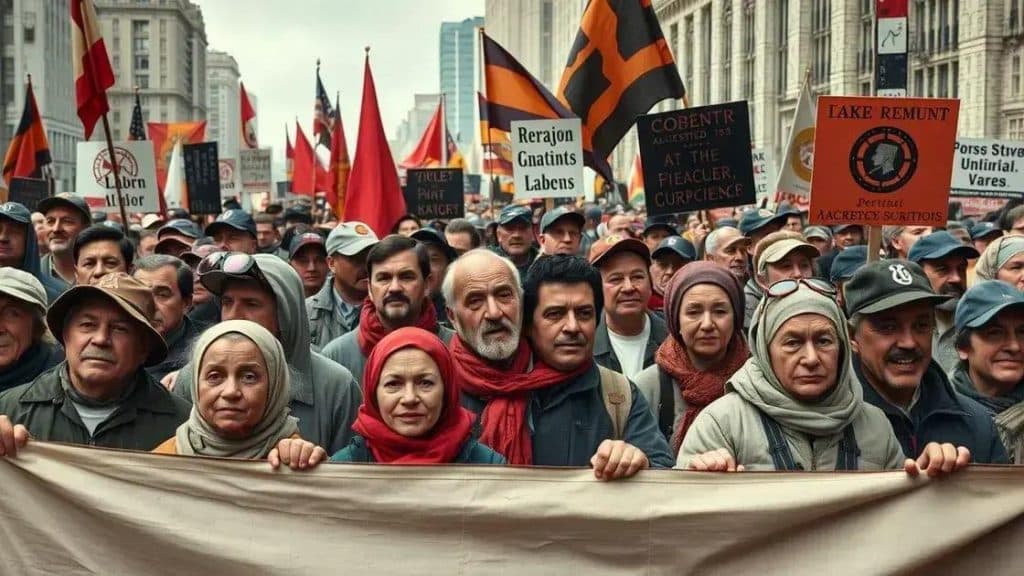Include labor movement stories to inspire activism

Labor movements are organized efforts by workers to improve rights, wages, and working conditions, significantly influencing modern workplace standards through collective action and strategic advocacy.
Include labor movement stories that highlight the struggles and victories of workers throughout history. These narratives not only educate but also inspire action. Are you ready to dive into these impactful tales?
Historical context of labor movements
The historical context of labor movements is essential to understand how workers achieved rights today. Labor movements have arisen from the need for better wages, working conditions, and job security. Understanding the struggles of the past provides insight into ongoing efforts for equality.
Key Events in Labor History
Several pivotal events shaped the labor movement. From early strikes to major legislation, these moments are critical:
- The Pullman Strike of 1894 highlighted the struggles against unfair labor practices.
- The establishment of Labor Day in 1894 recognized workers’ contributions nationwide.
- The Great Railroad Strike of 1877 marked one of the first major nationwide labor actions.
- The Triangle Shirtwaist Factory fire of 1911 sparked significant reforms in workplace safety.
These events stand as reminders of the courage and determination displayed by workers fighting for their rights. The achievements they made did not come easily and often involved great sacrifice.
As labor movements grew, they started to make an impact on legislation. Protections for workers began to take shape, leading to better pay, shorter hours, and improved safety regulations. This evolution was not uniform; different regions and industries experienced varying levels of progress.
The Role of Unions
Unions played a significant role in advocating for workers. They provided structure and a unified voice. Over time, they became vital in negotiations for better conditions:
- Increasing wages helped uplift millions of workers.
- Health and safety regulations were born from union demands.
- Job security became a focal point during negotiations.
Through organized efforts, unions shaped labor laws, ensuring fairness and protections in the workplace. The impact of these movements laid the groundwork for many of the benefits that workers enjoy today.
Key figures in labor history
Understanding the key figures in labor history helps to appreciate the impact of the labor movement. Many individuals risked their lives to fight for workers’ rights and social justice. Their stories are powerful reminders of the struggle and achievements of the workforce.
Influential Leaders
Some leaders stand out for their significant contributions:
- Samuel Gompers was the first president of the American Federation of Labor (AFL). He pushed for better wages and hours for workers.
- Mary Harris “Mother” Jones was a prominent labor activist who fought for children’s labor laws.
- John L. Lewis helped establish the Congress of Industrial Organizations (CIO), supporting both unskilled and skilled labor.
These leaders not only organized workers but also brought important issues to the forefront of public awareness. Through their efforts, they inspired others to join the fight for equality and fairness in the workplace.
Each figure navigated challenges and faced resistance to their movements. For instance, Mother Jones‘s tireless campaigning for coal miners highlighted the unsafe working conditions many faced. Her dedication sparked greater awareness and action towards reform.
Their Lasting Legacies
The impact of these key figures is still felt today. They laid the foundation for many rights that workers enjoy. Thanks to their advocacy, many labor laws were enacted to protect workers:
- Minimum wage laws established to ensure fair compensation.
- Child labor laws protect minors from exploitation.
- Workplace safety regulations aim to prevent accidents and injuries.
These contributions remind us of the importance of standing up for workers’ rights. The sacrifices made by these individuals continue to inspire future generations to advocate for social justice and equality in the workforce.
Impact of labor movements on modern rights

The impact of labor movements on modern rights is profound and far-reaching. These movements laid the groundwork for many of the rights that workers enjoy today. Understanding their influence helps us appreciate the progress made over the years.
Advancements in Workers’ Rights
Labor movements have driven significant advancements. They have championed key issues such as:
- Minimum wage laws ensure that workers receive fair pay for their labor.
- Health and safety regulations protect employees from hazardous working conditions.
- Collective bargaining rights allow workers to negotiate better terms with their employers.
These rights reflect the hard-fought battles waged by previous generations. The persistence and resilience of workers showed that change is possible through organized efforts.
Beyond basic rights, labor movements addressed broader social issues. For instance, they fought against discrimination and for gender equality in the workplace. This advocacy paved the way for policies that support diversity and inclusion today.
Ongoing Challenges and Progress
While significant strides have been made, challenges remain. Workers still face issues like job insecurity and wage stagnation. Labor movements continue to respond to these challenges, advocating for:
- Stronger protections against unfair layoffs.
- Living wages that reflect the cost of living.
- Access to benefits such as healthcare and paid leave.
The fight for fairness and equality persists, adapting to the needs of modern workers. This ongoing struggle highlights the relevance of labor movements in today’s society.
As we reflect on the impact of labor movements, it is necessary to recognize their role in shaping today’s work environment. The victories achieved through these movements continue to inspire new generations to advocate for their rights.
Stories of successful labor actions
The stories of successful labor actions showcase the power of solidarity and the impact of organized efforts. These narratives not only highlight key victories but also serve as inspiration for ongoing movements. Understanding these actions helps illustrate how collective bargaining can lead to significant change.
The Pullman Strike
One of the most notable labor actions occurred during the Pullman Strike of 1894. Workers at the Pullman Company protested wage cuts and high rents in company housing. This widespread strike disrupted rail traffic across the nation, demonstrating the strength of coordinated efforts.
- The strike led to nationwide awareness of the struggles faced by workers.
- It resulted in the establishment of Labor Day as a national holiday.
- The government’s intervention raised questions about workers’ rights and federal authority.
This event highlighted the critical need for workers to unite and advocate for fair treatment.
The Twin Cities Strikes
Another successful action was the Twin Cities Strikes in 1934, where warehouse workers in Minneapolis engaged in a general strike. They fought for better wages and working conditions. The solidarity shown led to:
- Improved pay and benefits for warehouse workers.
- The establishment of stronger unions within the industry.
- A renewed focus on workers’ rights across other sectors.
This action demonstrated how unified voices could bring about lasting changes in labor policies.
Every successful labor action serves as a testament to resilience and determination. These stories of triumph not only celebrate past victories but also keep the spirit of activism alive. By recognizing these achievements, we can inspire new generations to continue the fight for justice and equality in the workplace.
Lessons learned from labor movements
The lessons learned from labor movements are crucial for understanding the evolution of workers’ rights and activism. These movements have taught us about the importance of solidarity, persistence, and strategic action in achieving social change.
The Power of Unity
One of the key takeaways is the strength that comes from unity. When workers come together, they can amplify their voices and demands. This was evident in various strikes where collective action led to significant victories:
- Labor solidarity enables workers to negotiate better wages.
- United efforts draw public attention to workers’ issues.
- Common goals foster a sense of community and shared purpose.
Such unity highlights how individual actions are often more impactful when combined with similar efforts from others.
The Importance of Strategy
Another essential lesson is the need for strategic planning. Successful labor movements often relied on careful organization and clear objectives. Examples include:
- Using negotiation tactics to reach agreements with employers.
- Planning effective protests and rallies to gain public support.
- Creating alliances with other social movements to strengthen their cause.
These strategies show that achieving change is not just about passion, but also about intelligent planning and execution.
Adapting to Change
The labor movements have also illustrated the need to adapt to changing circumstances. As the economy and workplace environments evolve, so must the tactics of labor activists. They have learned to be responsive to:
- Shifts in public opinion regarding workers’ rights.
- Economic changes that affect job security and wages.
- Technological advancements that alter how work is done.
This adaptability ensures that movements remain relevant and continue to fight for the rights of workers effectively. These lessons continue to inform current and future labor actions, showing that the struggle for justice and fairness is ongoing.
In conclusion, the rich history of labor movements provides valuable lessons for the present and future. These movements demonstrate the power of unity, showing that when workers come together, they can effectively advocate for their rights. Key figures from the past have faced considerable challenges, yet their stories illuminate the path forward. Today, as we reflect on past victories and learn from the strategies employed, we can continue to push for fair treatment, equality, and justice in the workplace. It’s vital that we remember these lessons as we stand in solidarity for workers’ rights, adapting to the ever-changing landscape of work and society.
FAQ – Frequently Asked Questions about Labor Movements
What are labor movements?
Labor movements are organized efforts by workers to improve their rights, wages, and working conditions through collective action.
Why are historical labor actions important?
Historical labor actions provide valuable lessons on the power of unity, strategy, and the ongoing fight for workers’ rights.
How do labor movements impact modern workplace rights?
Labor movements have established crucial rights such as minimum wage, workplace safety regulations, and the right to unionize.
What can we learn from successful labor actions?
Successful labor actions teach us that solidarity, strategic planning, and adaptability are key components in achieving lasting change.





